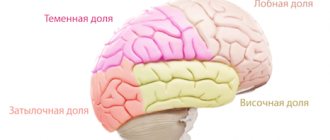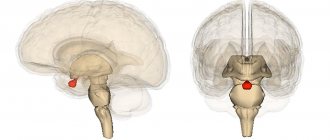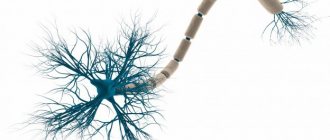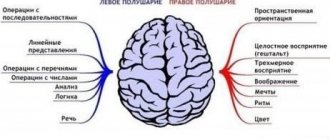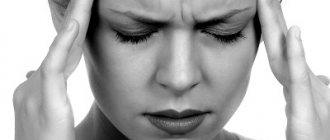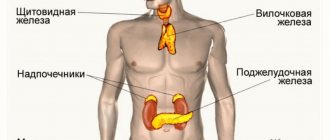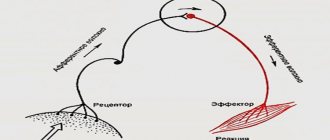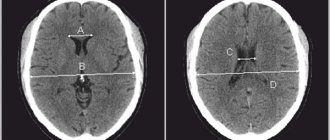Man is the only species on earth that, in addition to satisfying the needs dictated by instincts, is capable of carrying out emotional, creative and mental activities. The uniqueness of people lies in the presence of extensive, highly developed and complexly constructed areas of the brain, which have the general name neocrtex. Therefore, in the study of man, as a species at the upper stage of evolution, the main directions are questions about the structure and functions of this part of the central nervous system.
General information
The neocortex (new cortex, isocortex or lat. neocortex) is an area of the cerebral cortex, occupying about 96% of the surface of the hemispheres and having a thickness of 1.5 - 4 mm, which are responsible for the perception of the surrounding world, motor skills, thinking and speech.
The neocortex consists of three main types of neurons - pyramidal, stellate and fusiform. The first, the most numerous group, which makes up about 70-80% of the total amount in the brain. The proportion of stellate neurons is at the level of 15-25%, and fusiform neurons - about 5%.
In its structure, the neocortex is almost homogeneous and consists of 6 horizontal layers and vertical columns of the cortex. The layers of the new cortex have the following structure:
- Molecular, consisting of fibers and a small number of small stellate neurons. The fibers form a tangential plexus.
- The outer granular layer is formed by small neurons of various shapes, which are connected to the molecular layer over the entire area. At the very end of the layer there are small pyramidal cells.
- External pyramidal, consisting of small, medium and large pyramidal neurons. The processes of these cells can be associated with both layer 1 and the white matter.
- Internal granular, which consists mainly of stellate cells. This layer is characterized by a loose arrangement of neurons.
- Internal pyramidal, formed by medium and large pyramidal cells, the processes of which are connected with all other layers.
- Polymorphic, the basis of which is made up of spindle-shaped neurons, connected by processes with layer 5 and white matter.
In addition, the neocortex is divided into areas, which in turn are subdivided into Brodmann areas. The following areas are distinguished:
- Occipital (17,18 and 19 fields).
- Superior parietal (5 and 7).
- Inferior parietal (39 and 40).
- Postcentral (1, 2, 3 and 43).
- Precentral (4 and 6).
- Frontal (5, 9, 10, 11, 12, 32, 44, 45, 46 and 47).
- Temporal (20, 21, 22, 37, 41 and 42).
- Limbic (23, 24, 25 and 31).
- Ostrovkovaya (13 and 14).
The cortical columns are a group of neurons that are located perpendicular to the cerebral cortex. Within a small column, all cells perform the same task. But a hypercolumn, consisting of 50-100 mini-columns, can have one or many functions.
Functional systems
It must be said that of all the areas of the brain, the cortex demonstrates the greatest evolutionary success, although it began to evolve relatively recently. Unlike the highly conserved medulla oblongata, which performs important functions such as regulating heart rate and monitoring breathing, many areas of the cortex do nothing about survival.
The neocortex is rightfully considered the main achievement of evolution and the substrate of human mental development. Although its rudiments first appeared in reptiles that lived in the Carboniferous period. The old, original version of this layer was a homogeneous six-layer sheet consisting of neurons. The size, as well as the complexity, of the cortex has almost reached perfection in modern humans, who, by the way, separated from the level of the mouse almost 100 million years ago. If any new organ were to significantly differentiate humans from other species, it would be the neocortex, the center of the extraordinary abilities of Homo sapiens.
Sensory area
The cortex is connected to various subcortical structures. The parts of the cortex that receive sensory signals from the thalamus (the part of the brain with a lot of gray matter) are called primary sensory areas. Each of the five senses refers to specific groups of brain cells that classify and integrate information. The five generally accepted sensory modalities, including vision, hearing, taste, touch, and smell, are arranged as follows:
The somatosensory cortex is located across the central sulcus. It is configured in a special way to match neighboring motor cells associated with specific parts of the body. The most sensitive areas are the lips and fingertips. The main taste area is located in the postcentral gyrus. Olfaction is the only sensory system that does not pass through the thalamus. It is located along the inferior surface of the temporal lobe. The visual zone is located deep in the occipital lobe and is hidden inside the folds. The primary auditory cortex is located on the transverse gyrus.
Each hemisphere of the brain receives information from the opposite side of the body. For example, the right primary somatosensory cortex knows what the left limbs are doing, and the right visual area processes signals received from the left eye. Cortical sensory maps reflect the structure of the corresponding sensory organ, which is called a topographic scheme. Examples of cards:
- retinotopic - corresponds to points in the retina of the eye;
- tonotopic - in the primary auditory cortex;
- somatotopic - in the primary sensory cortex (schematically looks like a distorted image of a person).
Motor areas
They are located like a pair of headphones, extending from ear to ear, in both hemispheres of the cortex. Participate in the control of voluntary movements, especially small ones performed by the hands. The right half of the motor area controls the left side of the body, and the left half controls the right.
Primary motor cortex. Makes a major contribution to the generation of nerve impulses that control the execution of movement. For example, elbow flexion. Premotor cortex. Very similar to the previous one, but is responsible for more complex movements. Additional motor zone. Plans motor activity, is responsible for the sequence of movements, and also coordinates both sides of the body.
In addition, motor functions have been described for the posterior parietal cortex, which directs voluntary movements in space. But the dorsolateral prefrontal cortex decides how and where to move in accordance with the instructions (thoughts) generated by the brain. Most neurons in the motor cortex project to synapses in the spinal cord. They affect a number of muscles and joints.
Association fields
They produce a meaningful perception of the world, allow a person to effectively interact with the environment, and support abstract thinking and speech. The parietal, temporal, and occipital lobes are located in the back of the brain and transform sensory information into a consistent model of perception of the environment, relating it to past experience. That is, globally the association's areas are organized as distribution networks. These connections are of great importance for language function.
Functions of neocortex
The new cortex is responsible for performing higher nervous functions (thinking, speech, processing information from the senses, creativity, etc.). Clinical trials have shown that each area of the cerebral cortex is responsible for strictly defined functions. For example, human speech is controlled by the left frontal gyrus. However, if any of the areas is damaged, the neighboring one can take over its function, although this requires a long period of time. Conventionally, there are three main groups of functions performed by the neocortex - sensory, motor and associative.
Sensory
This group includes a set of functions with the help of which a person is able to perceive information from the senses.
Each sense is analyzed by a separate area, but signals from others are also taken into account.
Signals from the skin are processed by the posterior central gyrus. Moreover, information from the lower extremities goes to the upper part of the gyrus, from the body to the middle part, from the head and hands to the lower part. In this case, the posterior central gyrus processes only pain and temperature sensations. The sense of touch is controlled by the superior parietal region.
Vision is controlled by the occipital region. Information is received in field 17, and in fields 18 and 19 it is processed, that is, color, size, shape and other parameters are analyzed.
Hearing is processed in the temporal region.
Charm and taste sensations are controlled by the hippocampal gyrus, which, unlike the general structure of the neocortex, has only 3 horizontal layers.
It is worth noting that in addition to the zones of direct reception of information from the senses, next to them there are secondary ones, in which the relationship between the received images and those stored in memory occurs. When these areas of the brain are damaged, a person completely loses the ability to recognize incoming data.
Motor
This group includes the functions of the neocortex, with the help of which any movement of the human limbs is carried out. Motor skills are controlled and controlled by the precentral region. The lower limbs depend on the upper parts of the central gyrus, and the upper limbs depend on the lower ones. In addition to the precentral, the frontal, occipital and superior parietal regions are involved in movement. An important feature of the performance of motor functions is that they cannot be performed without constant connections with sensory areas.
Associative
This group of neocortical functions is responsible for such complex elements of consciousness as thinking, planning, emotional control, memory, empathy and many others.
Associative functions are performed by the frontal, temporal and parietal regions.
In these areas of the brain, a reaction to data coming from the senses is formed and command signals are sent to the motor and sensory areas.
To receive and control, all sensory and motor areas of the cerebral cortex are surrounded by associative fields, in which the received information is analyzed. But at the same time, it is worth considering that the data coming into these fields is already primarily processed in the sensory and motor areas. For example, if there is a disruption in the functioning of such an area in the visual area, a person sees and understands that there is an object, but cannot name it and, accordingly, make a decision about his further behavior.
In addition, the frontal lobe of the cortex is very tightly connected to the limbic system, which allows it to control and manage emotional messages and reflexes. This makes it possible for a person to develop as a person.
The performance of associative functions in the neocortex is possible due to the fact that the neurons of this part of the central nervous system are able to retain traces of excitation based on the feedback principle and can persist for a long time (from several years to a lifetime). This ability is memory, with the help of which associative connections of the information received are built.
Consciousness and unconsciousness. Higher intelligence. Three Minds Model
In all world religions there is the idea that a person has three aspects of consciousness, or let’s call them three minds.
Let's call the first mind the Conscious Mind.
The second is the Unconscious Mind.
And the third - by the Higher Mind.
And let’s agree that these three minds are three aspects of any personality.
If you look at the picture at the beginning of this article showing the structure of the brain and look for where our three minds reside, it looks like the Conscious Mind and the Higher Mind are located in the neocortex.
And the Unconscious wanders between the reptilian and limbic brain, from time to time sending signals to the neocortex, where the Higher and Conscious minds are located, in the form of images, sounds, feelings and bodily sensations.
- The higher mind resides not only in the neocortex of a particular person, but is somehow connected to the field of the collective unconscious beyond the individual person.
- The Higher Mind and the Conscious Mind do not communicate directly. They ALWAYS interact through the Unconscious. This is why a person has psychological problems. But we'll talk about this a little later.
So, what is our Higher Mind responsible for?
For ideas, foresight, values, meaning, spirituality, self-control.
It seems that the Higher Mind of each person has a special task regarding the life of a person.
This task can be called a mission or purpose. This most important task in life is closely related to deep identity, the awareness of who I am, and without which my life has no meaning.
What is under the control of the Conscious Mind?
Perception of reality, that is, those images, sounds, bodily sensations, internal dialogues that we are aware of.
Rational and logical thinking.
Making informed decisions.
The unconscious is a giant repository of everything, everyone, everyone
events that have ever happened to us,
emotions we've ever felt
the decisions we made
internal and external conflicts,
beliefs and principles,
physiological processes in our body.
How do Consciousness, the Unconscious and the Higher Mind interact with each other?
Creates tensions and diseases in our body.
Cuts scars on our emotions.
It clouds our states.
It creates traffic jams and stagnation in our thoughts and actions.
Silences the call of our true values and important life goals.
The role of the neocortex in emotions and stereogynesis
Emotions in humans initially appear in the limbic system of the brain. But in this case they are represented by primitive concepts, which, once in the new cortex, are processed using the associative function. As a result, a person can operate with emotions at a higher level, which makes it possible to introduce concepts such as joy, sadness, love, anger, etc.
The neocortex also has the ability to dampen strong outbursts of emotion in the limbic system by sending calming signals to areas of high neuronal excitability. This leads to the fact that in a person the dominant role in behavior is played by the mind, and not by instinctive reflexes.
And now the most wonderful news!
Creative people have already come up with a lot of affordable and environmentally friendly ways to consciously synchronize the work of our brain.
That is, we have everything you need to create!
Download the unique book “2 Secrets of Inspiration”
This book will talk about how to quickly bring yourself into a working creative state of mind and soul, how to invite Inspiration at the right moment in time.
An inspired person is very effective and productive, he is so strongly involved in the process of inventing that he very quickly and with pleasure composes, writes, speaks, invents, draws, creates, sculpts, improvises.
What do you need to do to get inspired?
How to get ideas out of your own head?
How can you enter the Creative space at your will at the right moment, without waiting for the Muse?
Download the free book and find out!
Differences from old bark
The old cortex (archicortex) is an earlier emerging part of the cerebral cortex than the neocortex. But in the process of evolution, the new cortex became more developed and extensive. In this regard, the archicortex ceased to play a dominant role and became one of the constituent parts of the limbic system.
If we compare the old one in terms of the functions performed, then the first is assigned the role of fulfilling innate reflexes and motivation, and the second - managing emotions and actions at a higher level.
In addition, the neocortex is significantly larger in size than the old cortex. So the first occupies about 96% of the total surface of the hemispheres, and the size of the second is no more than 3%. This ratio shows that the archicortex cannot perform higher nervous functions.
Three brains
If you look at the picture, you will see that the theory of three types of brain is quite realistic.
Scientific research proves that each of them has its own specific location in our body.
He is responsible for instincts, speed and survival. Reacts without thinking in order to protect the body from danger.
Hit! Run! Freeze! Thanks to these reactions, living beings were saved from their enemies. Instinctively and without emotion.
A purely muscular reaction that turns on and off the motor activity of a creature when it senses danger or hunger, fear or pleasure.
It fits around the reptilian brain like a glove. And is responsible for emotions and behavior in the pack, that is, collectivism, teamwork, family.
Thanks to this brain, animals learn. They have emotions. They follow a hierarchy. They know how to act together: in pairs or in a flock.
The limbic brain is responsible for feelings, dominance, learning, defense, awareness of the present, similarity and the desire to adhere to familiar patterns of life, auditory perception and discrimination of rhythm and intonation.
It is complex, unstable, flexible and continues to evolve.
The neocortex is NOT integrated with the emotional and reptilian brain.
He knows how to analyze, synthesize, generalize, plan and reason.
The neocortex allows you to visualize the future, create dissociated images. That is, images that you and I can look at from the outside, from the position of an observer.
But most importantly, he knows how to foresee, fantasize and dream. And express thoughts using words. By the way, the language system is the youngest in the neocortex.
In the book by the philosopher George Gurdjieff, “Everything and Everything,” the hero tells his grandson all about the “incomprehensible behavior of three-brained creatures on this strange planet Earth,” in which each of the three minds is in charge of its own sphere.
I am very grateful to my reptilian brain, which once, and maybe dozens of times, saved me in critical situations. For example, from a head-on collision with a bus. This happened in Malta, when my neocortex, wrapped in dreams of warm sand and gentle sea waves, almost killed me. I walked and dreamed. I was walking and didn’t notice how I stepped onto the roadway. She walked, staring inside herself, rejoicing in her dreams. What made me jump back and press myself against the wall exactly a second before a huge tourist bus squeezed into the narrow street? Reptilian brain.
I am very grateful to my limbic brain, which makes it possible to feel the experiences and states of other people, to empathize, sympathize, build relationships with different people and groups, and avoid relationships that destroy me.
The relationship with the smart neocortex is always complex. It is beautiful and powerful when you start a new project, plan, go towards a goal, look for ideas to solve problems and tasks. But it also makes you worry and worry about imaginary dangers, gives false directions and leads you into a dead end.
Molecular layer
It is the most superficial in the cytoarchitectonics of the cortex, located directly under the soft shell (pia mater encephali). This layer is very poor in cellular components, which are represented by only a few horizontal Cajal-Retzius cells. Most of it is actually represented by the processes of neurons lying in deeper layers and their synapses.
Most dendrites are derived from pyramidal and spindle cells, whereas axons are actually the terminal fibers of the thalamocortical afferent tract, which originates from the nonspecific, intralaminar and midline nuclei of the thalamus.
Fibers of conscious proprioceptive sensitivity
This pathway originates with its receptors in the tendons, periosteum, muscles and ligaments, as well as in the joint capsules. In this case, complete information is provided about vibrations, body position, degree of relaxation and muscle contraction, pressure and weight. The neurons of this pathway are located in the spinal ganglia, the nuclei of the sphenoid and thin tubercles of the medulla oblongata, and the optic thalamus of the diencephalon, in which the switching of impulses then begins. Information is analyzed and ends its path in the central gyrus of the cerebral cortex. This path includes three tracts:
- Thalamocortical, which ends in the projection center, that is, in the central gyrus of the brain.
- Thin and wedge-shaped bundles passing in the posterior cord of the spinal cord.
- The bulbar-thalamic tract passes through the tegmentum of the brain stem.
